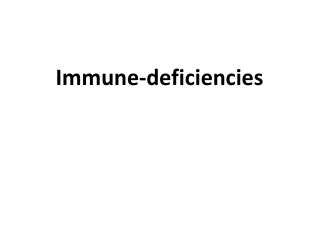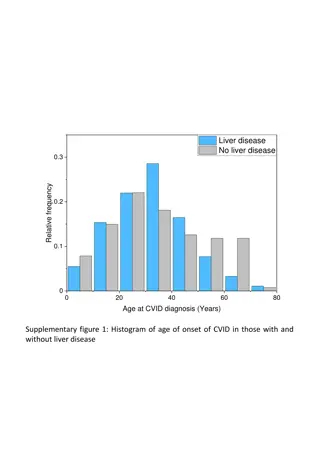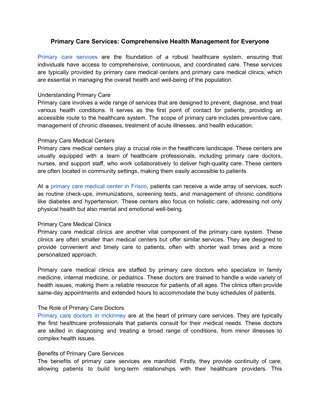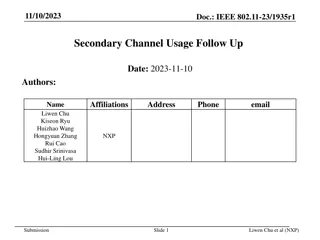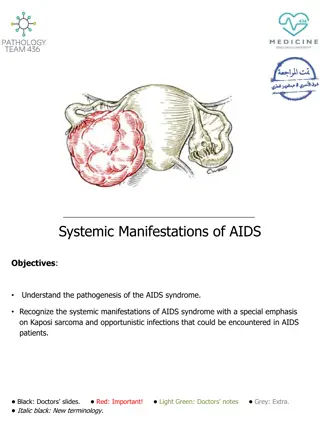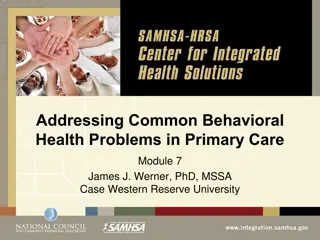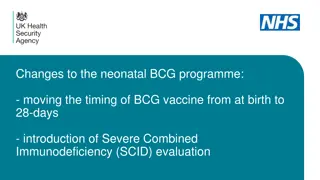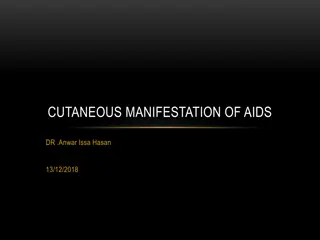Primary Immunodeficiency
Autoimmunity, hypersensitivity, and immune system failure in primary immunodeficiency result in susceptibility to various infections. Deficiencies in humoral and cell-mediated immunity impact the body's ability to fight off different pathogens, making patients vulnerable to opportunistic infections. Learn about warning signs, types of immune deficiency diseases, and specific conditions like Chronic Granulomatous Disease.
Download Presentation

Please find below an Image/Link to download the presentation.
The content on the website is provided AS IS for your information and personal use only. It may not be sold, licensed, or shared on other websites without obtaining consent from the author.If you encounter any issues during the download, it is possible that the publisher has removed the file from their server.
You are allowed to download the files provided on this website for personal or commercial use, subject to the condition that they are used lawfully. All files are the property of their respective owners.
The content on the website is provided AS IS for your information and personal use only. It may not be sold, licensed, or shared on other websites without obtaining consent from the author.
E N D
Presentation Transcript
Primary Immunodeficiency Refif S. Alshawk 2020
Autoimmunity system attacks host cells and tissues Hypersensitivity- unfavorable immune response Immune system is subject to failure of some or all of its parts: Immunodeficiency system fails to protect Primary immunodeficiency Genetic or developmental defect Secondary immunodeficiency - acquired
Loss or reduction of: Cell type Mechanisms of Immunodeficiency Cell numbers Cell function
Immunodeficiency Deficient humoral immunity usually results in increased susceptibility to infection by encapsulated, pus-forming bacteria and some viruses, Where as defects in cell-mediated immunity lead to infection by viruses and other intracellular microbes. Combined deficiencies in both humoral and cell mediated immunity make patients susceptible to infection by all classes of microorganisms. also affect the humoral system, because of the requirement for T-H cells particularly in the production of specific antibody Immunodeficient patients, defects in cellular immunity, often present with infections by microbes that are commonly encountered but effectively eliminated by healthy persons; such infections are said to be opportunistic. Defects in innate immunity can result in different categories of microbial infections, depending on the pathway or cell type affected. Complement deficiencies, instance, resemble deficiencies in presentation, Natural killer deficiencies result recurrent viral infection. for antibody clinical their in B-cell activation. (NK) mainly cell in especially those with
10 Warning Signs of Primary Immunodeficiency. Jeffrey Modell Foundation. Retrieved from info4pi.org.
Types of Types of immune immune deficiency deficiency diseases diseases:
Disease Molecular defect(s) Symptoms Chronic granulomatous disease(CGD) Def of NADPH oxidase; failure to generate superoxide anion & other O2 radicals, so the microorganisms will be ingested but not killed. 1. Recurrent infections with catalase- positive bacteria & fungi. 2. Patients not subject to infection by those bacteria, such as pneumococcus, that generate their own hydrogen peroxide. Chronic Granulomatous Disease (CGD): patients are very susceptible to opportunistic infection with bacteria & fungi. CGD is due to a defect in the intracellular microbicidal activity of neutrophils as a result of a lack of NADPH oxidase activity no hydrogen peroxide or superoxides, so the microorganism will be ingested but not killed. The addition of IFN- has been shown to restore function to CGD granulocytes and monocytes in vitro. This observation prompted clinical trials of IFN- for CGD patients. Leukocyte Adhesion deficiency syndrome (LAD): cell-surface molecules belonging to the integrins family of proteins function as adhesion molecules and are required to facilitate cellular interaction. These patients have defective adhesion (LFA-1) proteins on the surface of their phagocyte neutrophil adhere poorly to endothelial cell surface & phagocytosis of the bacteria is inadequate. Leukocyte adhesion deficiency(LAD) Absence of CD18(LFA-1) (leukocyte integrins). phagocytosis of the bacteria is inadequate 1. Recurrent & chronic infection. 2. Fail to form pus. Chediak- Higashi Syndrome Defect in organelle membrane which inhibits normal fusion of lysosomes Fail to destroy ingested microbes Recurrent infection with bacteria (chemotactic and defects, absent NK activity, partial albinism) degranulation Defects of phagocytic cells as for example:
Disease Molecular defect Symptoms/signs Treatment Defects of humoral immunity. The B-cell defect is usually not detected for the first few months of life because of the passive transfer of Ig from the mother through the placenta and/ or colostrums. These patients are subjected to recurrent bacterial infection, but normal immunity to viral & fungal infection, because T-cell branch is not affected. These patients tend to have infection by encapsulated bacteria (staphylococcus, streptococcus, and pneumococcus), as Ab is critical for opsonization & clearance of these organisms. 1. Monthly gammaglobulin replacement. 2. Antibiotic for infection. Deficiency of tyrosine kinase, so blocks B-cell maturation. 1. 2. 3. Low Ig of all classes. No circulating B cell. B-cell maturation stopped at pre-B stage Normal CMI. Bruton X-linked Agammagloulinemia 4. Antibiotic & gammaglobulin. Deficiency of CD40L on activated T cell. 1. Higher serum titer of IgM only. 2. Normal B & T cell number. 3. Susceptibility to extracellular bacteria & opportunists. X-linked hyper-IgM syndrome Antibiotic, not immunoglobulin Deficiency of IgA Unknown Repeated sinopulmonary & GIT infections. 1. Onset in late teens. 2. B cell present in peripheral blood. 3. Ig level decrease with time. 4. Increase autoimmunity & atopy. Selective IgA deficiency Antibiotics Common variable immunodef Antibiotic & in severe cases gammaglobulin replacement. Delayed onset of normal IgG synthesis Susceptibility to pyogenic bacteria. Transient hypogammaglobulinemia of infancy
Disease Molecular defect Symptoms/signs Treatment Defects of humoral immunity 1. Monthly gammaglobulin replacement. 2. Antibiotic for infection. Bruton X-linked Agammagloulinemia Deficiency of tyrosine kinase, so blocks B-cell maturation. 1. Low Ig of all classes. 2. No circulating B cell. 3. B-cell maturation stopped at pre-B stage 4. Normal CMI. X-linked Agammaglobulinemia B cell defect - Defect in kinase that keeps B cells in pre-B stage Low levels of IgG and absence of other classes Recurrent bacterial infections Antibiotic & gammaglobulin. X-linked hyper-IgM syndrome Deficiency of CD40L on activated T cell. 1. Higher serum titer of IgM only. 2. Normal B & T cell number. 3. Susceptibility to extracellular bacteria & opportunists. Antibiotic, not immunoglobulin Selective IgA deficiency Deficiency of IgA Repeated sinopulmonary & GIT infections. Unknown 1. Onset in late teens. 2. B cell present in peripheral blood. 3. Ig level decrease with time. 4. Increase autoimmunity & atopy. Delayed onset of normal IgG synthesis Antibiotics Common variable immunodef Antibiotic & in severe cases gammaglobulin replacement. Transient hypogammaglobulinemia of infancy Susceptibility to pyogenic bacteria.
X-linked hyper-IgM syndrome (XHM): The defect is in the gene encoding the CD40 ligand (CD40L), which maps to the X chromosome. T-helper cells from patients with XHM fail to express functional CD40L on their membrane. Since an interaction between CD40 on the B cell and CD40L on the T-H cell is required for B-cell activation, the absence of this co-stimulatory signal inhibits B-cell response to T-dependent antigens. The B-cell response to T-independent antigens, is unaffected by this defect, accounting for the production of IgM antibodies. Class switching and formation of memory B-cells both require contact with T-H cells by a CD40 CD40L interaction. The absence of this interaction in XHM results in the loss of class switching to IgG, IgA, or IgE isotypes and in a failure to produce memory B cells.
Selective deficiencies of Ig classes: A number of immunodeficiency states are characterized by significantly lowered amounts of specific immunoglobulin isotypes. Of these, IgA deficiency is the most common. The defect in IgA deficiency is related to the inability of IgA B cells to undergo normal differentiation to the plasma-cell stage. IgG2 and IgG4 may also be deficient in IgA-deficient patients. No causative defect in IgA genes has been identified, and the surface IgA molecules on these patients B cells appear to be expressed normally. A gene outside of the immunoglobulin gene complex is suspected to be responsible for this fairly common syndrome. Common variable immunodef (CVI): is characterized by a profound decrease in numbers of antibody-producing plasma cells, low levels of most immunoglobulin isotypes (hypogammaglobulinemia), and recurrent infections. The condition is usually manifested later in life than other deficiencies and is sometimes called late onset hypogammaglobulinemia or, incorrectly, acquired hypogammaglobulinemia. However, CVI has a genetic component and is considered a primary immunodeficiency, although the exact pattern of inheritance is not known. Infections in CVI sufferers are most frequently bacterial and can be controlled by administration of immunoglobulin. In CVI patients, B cells fail to mature into plasma cells.
Defects of T lymphocytes and sever combined ID. Disease Defect Clinical manifestation DiGeorge syndrome Thymic aplasia. Depression of T cell number with absence of responses. Although patients with defects in B lymphocytes can pathogens adequately, defects in T lymphocytes are observed throughout the immune system (because of the central role of T cells in activation, proliferation, differentiation, and modulation of all naturally occurring immune responses). The impact on the cell-mediated system can be severe, with a reduction in both delayed-type hypersensitive responses and cell-mediated cytotoxicity. The onset of infections begins early in infancy, and the prognosis for these infants is early death unless therapeutic intervention reconstitutes their defective immune system. deal with many MHC class I deficiency Failure of TAP 1 molecule to transport peptide to endoplasmic reticulum. 1. CD8+ Tcell def. 2. CD4+ T cell normal. 3. Recurrent viral infection. 4. Normal Ab formation. MHC class II def (Bare lymphocyte syndrome) Defects in transcription factors. 1. Def of CD4+ T cell. 2. Hypogammagloulinemia. 3. Clinically as severe combined ID. Ataxia telangiectasia Defect involved in the cell cycle. in kinase 1. Gait abnormality. 2. Telangectasia (capillary distortion in the eye). 3. Def of IgA & IgE production. Sever combined ID (SCID). Defects in common chain of IL-2 receptor. 1. Opportunistic (fungal) infection. 2. Low level of circulating lymphocyte.
Disease Defect Clinical manifestation B and T-cell deficiency divided into these categories: Thymic aplasia. Depression of T cell number with absence of responses. DiGeorge syndrome MHC class I deficiency Failure of TAP 1 molecule to transport peptide to endoplasmic reticulum. 1. CD8+ Tcell def. 2. CD4+ T cell normal. 3. Recurrent viral infection. 4. Normal Ab formation. Selective T-cell deficiency: 1. DiGeorge defect includes a profound depression of T-cell numbers and absence of T-cell responses. Although B cells are present in normal numbers, affected individuals do not produce antibody in response to immunization with specific antigens. The immune syndrome MHC class II def (Bare lymphocyte syndrome) Defects in transcription factors. 1. Def of CD4+ T cell. 2. Hypogammagloulinemia. 3. Clinically as severe combined ID. Ataxia telangiectasia 1. Gait abnormality. 2. Telangectasia (capillary distortion in the eye). 3. Def of IgA & IgE production. Defect involved cycle. in in kinase the cell 2. Bare lymphocytes syndrome II: Due to defect in the MHC class II transactivator protein gene, which results in a lack of class-II MHC molecule on APC. Patients have fewer CD4 cells, immunoglobulin levels decreased owing to defective T- cell help. Increased susceptibility to infection Sever ID (SCID). combined 1. Opportunistic (fungal) infection. 2. Low level of circulating lymphocyte. Defects in common chain of IL-2 receptor.
Disease Defect Clinical manifestation B and T-cell deficiency divided into these categories: Depression of T cell number with absence of responses. DiGeorge syndrome Thymic aplasia. 1. CD8+ Tcell def. 2. CD4+ T cell normal. 3. Recurrent viral infection. 4. Normal Ab formation. MHC class I deficiency Failure of TAP 1 molecule to transport peptide to endoplasmc reticulum. Combined partial B and T-cell deficiency: Ataxia telangiectasia Ataxia telangiectasia Defect in kinase involved in cell cycle Associated with a lack of coordination of movement (ataxis) and dilation of small blood vessels of the facial area (telangiectasis). T-cells and their functions are reduced to various degrees. B cell numbers and IgM concentrations are normal to low. 1. Def of CD4+ T cell. 2. Hypogammagloulinemia. 3. Clinically as severe combined ID. MHC class II def (Bare lymphocyte syndrome) Defects in transcription factors. 1. Gait abnormality. 2. Telangectasia (capillary distortion in the eye). 3. Def of IgA & IgE production. Ataxia telangiectasia Defect involved in the cell cycle. in kinase Defects in common chain of IL-2 receptor. 1. Opportunistic (fungal) infection. 2. Low level of circulating lymphocyte. Sever combined ID (SCID).
B and T-cell deficiency divided into these categories: Disease DiGeorge syndrome MHC class I deficiency Defect Thymic aplasia. Clinical manifestation Depression of T cell number with absence of responses. 1. CD8+ Tcell def. 2. CD4+ T cell normal. 3. Recurrent viral infection. 4. Normal Ab formation. Failure of TAP 1 molecule to transport peptide to endoplasmic reticulum. Defects in transcription factors. Complete functional B and T cell deficiency: The family of disorders termed SCID stems from defects in lymphoid development that affect either T cells or both T and B cells. All forms of SCID have common features despite differences in the underlying genetic defects. Clinically, SCID is characterized by a very low number of circulating lymphocytes. There is a failure to mount immune responses mediated by T cells. few circulating T cells in the SCID patient do not respond to stimulation by mitogens, indicating that they cannot proliferate in response to antigens. Myeloid and erythroid (red blood- cell precursors) cells appear normal in number and function, indicating that only lymphoid cells are depleted in SCID. SCID results in severe recurrent infections and is usually fatal in the early years of life. Although both the T and B lineages may be affected, the initial manifestation of SCID in infants is almost always infection by agents, such as fungi or viruses, which are normally dealt with by T-cell immunity. The B-cell defect is not evident in the first few months of the affected infant s life because antibodies are passively obtained from transplacental circulation or from mother s milk. MHC class II def (Bare lymphocyte syndrome) 1. Def of CD4+ T cell. 2. Hypogammagloulinemia. 3. Clinically as severe combined ID. Ataxia telangiectasia Defect involved in the cell cycle. in kinase 1. Gait abnormality. 2. Telangectasia (capillary distortion in the eye). 3. Def of IgA & IgE production. Sever ID (SCID). combined Defects in common chain of IL-2 receptor. 1. Opportunistic (fungal) infection. 2. Low level of circulating lymphocyte.
Components Deficiency Signs/diagnosis Defects of complement. Deficiencies of complement or its regulation as in these cases: Classic pathway C1q,C1r,C1s,C4,C2 1. Marked increase in immune complex disease 2. Increased infection with pyogenic bacteria. Deficiencies in components or functions, grouped as (early component, late component or alternative cascade deficiencies). These may result in: Both pathways C3 1. infection. 2. disease. Recurrent bacterial Hereditary angioedema. Absence of C1-inhibitor C1 act on C4 C4a vasoactive (C3a & C5a) capillary permeability and edema in several organs. 1. Immune complex 2. Recurrent infections Patient with C3 deficiency are particularly susceptible sepsis with pyogenic bacteria such as S. aurous. Those with reduced C6, C7 or C8 are prone to bacteremia with Neisseria meningitides or Neisseria gonorrhoeae. C5,C6,C7,C8 Recurrent meningococcal & gonococcal infections. 3. Autoimmune diseases: Patient with C2 & C4 deficiencies have autoimmune diseases. C3 deficiency are associated with SLE Def of regulatory proteins. C1-INH (hereditary angioedema). 1. Overuse of C1, C4 or C2. 2. Edema surfaces. at mucosal
References: Immunology , Kuby, seventh edition 2013 Immunology , Kuby, eighth edition 2019 Medical microbiology, Jawetz, 26thedition Cellular and Molecular Immunology, Abul K. Abbas, 8thedition.



